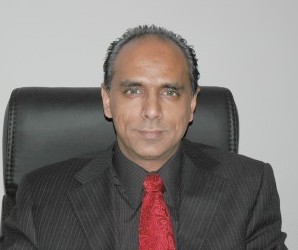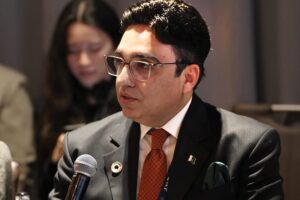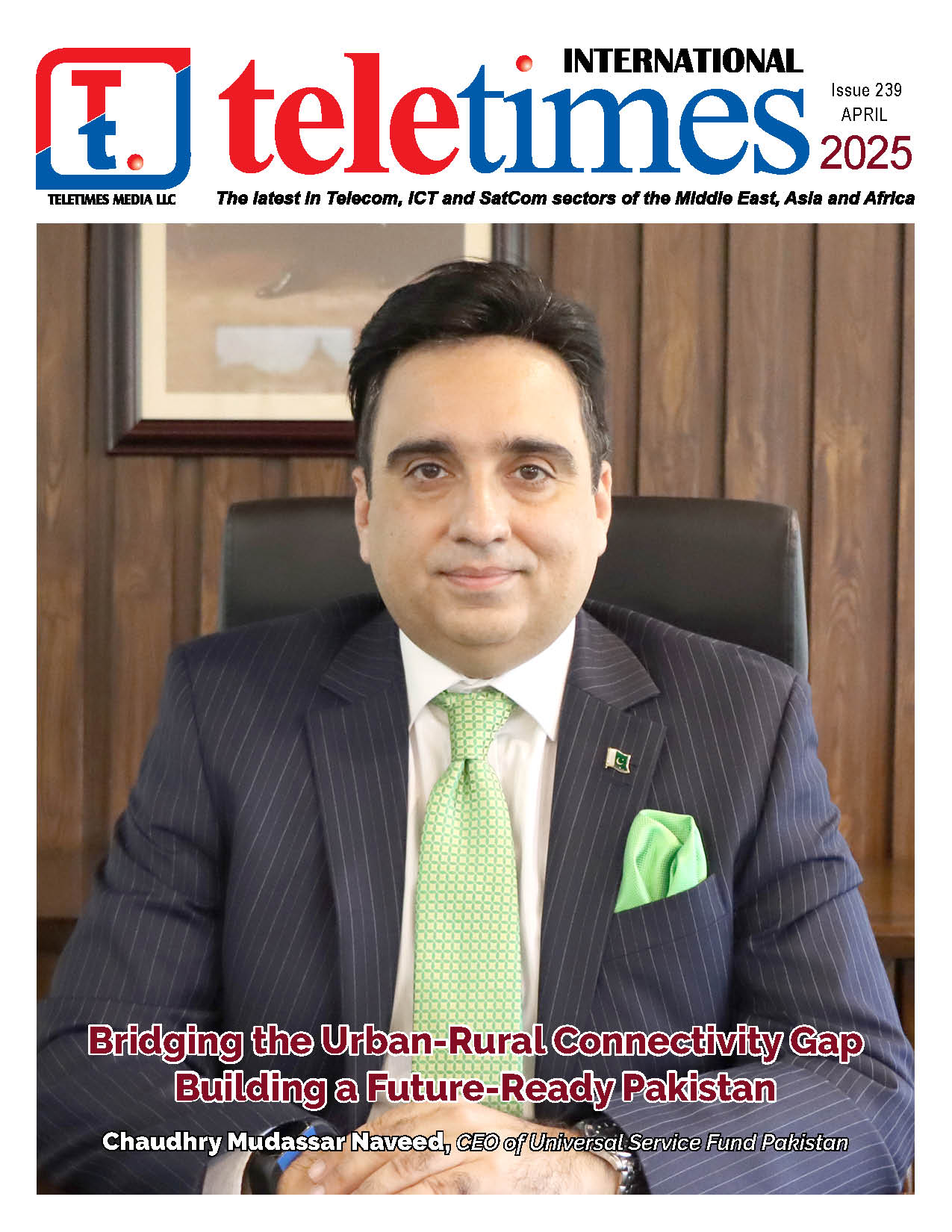Raheel Kamal
Head of Business Operations for Central Asia
Qualcomm
Interview: Gulraiz Khalid
 Raheel Kamal is Head of Central Asia, Global Business Operations, QUALCOMM Incorporated, headquartered in California, USA.
Raheel Kamal is Head of Central Asia, Global Business Operations, QUALCOMM Incorporated, headquartered in California, USA.
He has been involved in the development and deployment of CDMA and UMTS networks from the very onset. He has led many international mobile communications projects encompassing both cellular and satellite systems and has assisted major global mobile operators in their technology trials, network deployments, system optimizations, and technical trainings.
In his Business Development role, he works with a wide cross section of entities including policy making bodies, regulatory authorities, frequency planning boards, infrastructure and handset vendors, service providers, application developers, and investors alike and provides guidance on technology developments, policy issues, spectrum use, network operations and other business matters.
During and exclusive interview with Teletimes Raheel has discusssed the achivements of Qualcomm and the prevailing trends as well. The interview is given below:
Teletimes – Kindly elaborate as to what exactly Qualcomm is all about?
Raheel Kamal – Qualcomm is the world’s largest fabless semiconductor company headquarted in San Diego, California and is #1 in the wireless sector with over $10 Billion annual revenues. Qualcomm has its presence in 139 locations worldwide.
In a nut shell, Qualcomm is a technology development company and a value chain enabler. We invest heavily in the development of core mobile technologies, develop integrated chipsets and broadly license our Intellectual Property to our partners who bring end products to the consumers. To date, we have invested more than $16 billion just in R&D.
Qualcomm’s business model promotes competition and fosters continuous innovation and growth. This benefits the entire wireless industry by enabling more new players to enter the market.
We have licensed over 190 companies for CDMA, over 115 companies for WCDMA /TD SCDMA and have 9 royalty bearing OFDM /OFDMA single mode subscriber and infrastructure licensees.
TT – Now that we better understand what Qualcomm is about, can you please shed some more light on Qualcomm’s chipset solutions?
RK – Qualcomm’s chipset solutions address the needs of both the emerging and the developed markets. On one end, the mobile devices based on Qualcomm chipsets enable extremely affordable feature rich phones for the mass markets in the emerging parts of the world like Pakistan and on the other end, our solution enable highly integrated Smartphones starting with 1GHz single core processors to Quad core processors each operating at processing speeds of 2.5 Gigahertz per core.
Qualcomm’s SoC (system on chip) solutions integrate CPUs, GPUs (Graphics), modems, audio, video, GPS and wireless capabilities as well as firmware and software drivers. The high level of integration allows Qualcomm to optimize the system level performance and power consumption, and ensures best possible performance of mobile devices. The complete SoC solution reduces development time and cost.
Qualcomm ships over 400 Million chipsets per month for the mobile devices and to date has shipped over 7 billion chips. Its chipsets support multiple high level operating systems including Windows Mobile / Phone 7 and Android, etc. Over 750 device designs used Qualcomm chipsets in just 2010 and more than 130 Android devices (Smartphones and Tablets) launched by various vendors are supported by Qualcomm chipsets. Qualcomm is the first company in the world to deliver true 3G/4G multimode chipsets.
TT – What potential do you see in Pakistan for wireless communications in general and mobile broadband in particular?
RK – Pakistan witnessed tremendous growth in the mobile sector when the two new licenses were auctioned over five years ago. However, the growth has been pretty much stagnant for the last couple of years due to the currently deployed 2G technology that does not allow for providing high bandwidth data intensive value added services and applications which is the need of the hour. The ARPUs have declined to very low levels as the operators do not have much to compete upon except lowering the tariffs on thir voice / SMS packages. This has resulted in a price war eroding operator’s margins.
There is a large segment of the population in Pakistan that is interested in accessing Internet on the mobile phones but so far the high tariffs along with poor data speeds and the higher device prices have limited the uptake of data services. This is all set to change with the introduction of 3G technology in Pakistan.
The need for Internet connectivity is obvious. The user demand for data is on a continuous rise globally including Pakistan. Consumers are willing to pay much higher prices for the access to data services than for voice. Access to data on the go goes a step further in terms of subscribers’ willingness to pay a premium for the broadband that comes with mobility. Laptops, tablets and Smartphones are replacing desktop computers as they provide ubiquitous connectivity regardless of the user location.
The immense focus on education and the tech savvy younger generation in Pakistan along with the affordable data tariffs that can be offered on 3G networks create the neces for the uptake of mobile broadband Internet. While this certainly will benefit the consumer, the mobile operators will surely reap the benefits with much higher data ARPUs.
Over the last year, the Government of Pakistan has held various seminars and workshops for the telecom sector which have proven to be extremely vauable in developing an understanding of the technology and highlighting the need for immediate 3G network rollouts.
The deployment of high speed mobile broadband networks will also bring Foreign Direct Investment in the country and will have avery positive impact on the economic growth. It will create opportunities for the local IT and software industry where the application developers will be able to put their skills to use with local applications development.
TT – What is your take on 3G and 4G and what do you feel would be the right choice for Pakistan?
RK – First of all, the mobile licenses in Pakistan are ‘technology neutral’. The mobile operators have the discretion to choose whichever technology they wish to deploy, be it 3G or 4G. However, there are a few considerations that need to be taken into account when talking about 3G and 4G.
There is a lot of confusion about what is 3G and what is 4G. The ITU has recently determined that the term 4G could be used for the evolved 3G technologies referencing HSPA+ due to the evolution in the technology providing substantial level of improvement in performance. The specifications for the IMT Advanced technologies (LTE Advanced and WirelessMAN Advanced) will be finalized in its IRU R Recommendation expected in 2012.
3G has an extremely robust ecosystem that includes many successful operators and innovative vendors/developers motivated by prospects of achieving significant scale; as a result, the 3G ecosystem continues to thrive despite current economic challenges. Currently, there are over 1.2 billion 3G subscribers in the world with over 665 operators. According to industry analysts, the number of 3G subscriptions will reach 2.8 billion by 2014.
A key factor in choosing a given technology is the actual frequency spectrum that drives the decision due to availability of, or lack thereof, the infrastructure and devices. The current spectrum available in Pakistan that is under consideration, 2.1 GHz, for auction has been globally used for 3G / HSPA network deployments. There have been literally thousands of 3G devices including feature phones, smart phones, tablets, laptops with embedded 3G modems, USB dongles, e Readers, etc., commercially available for so many years. In comparison, there is no deployment of LTE in this particular frequency band and no availability of any commercial device.
I believe this presents a very clear choice of technology to the operators, i.e., HSPA+, whether you want to call it 3G or 4G.
TT – While the government has clearly indicated 3G spectrum auction to take place this year, what challenges you see might arise for the operators towards adoption of 3G and what steps should be taken in order to make 3 a success in Pakistan?
RK – The auction process has been delayed for far too long and that has created a challenge in itself. These delays create uncertainty and unpredictability of the government’s plans and make it very difficult for the operators an the rest of the industry that is linked with it, to plan anything. The delay in licensing is not only depriving the consumers to access a wide range of high speed mobile broadband services on latest and advanced devices but is also hampering the economic growth.
One of the operators’ concerns has been the anticipated bid amount for the 3G spectrum. A reasonable amount will make it a win win situation for all stake holders.
Once the auction process is completed, the operators will need to do proper network planning and optimization to ensure excellent quality of service is experienced by the users.
The introduction of appropriate handsets with relevant applications and services that provide value to the subscribers would be the key for the 3G uptake.
TT – What do you think will be the best way for the operators to increase the ARPU with 3G / 4G network deployments?
RK – As I mentioned earlier, although the recent price wars amongst operators have severely affected the operators’ ARPUs, there is definitely willingness on consumers part to pay more for the data services. The data ARPU for operators who have deployed CDMA EV‐DO networks in Pakistan are enjoying far greater ARPU levels which are a very clear indication of the affordability and desire f the Pakistani customer to use data centric services. However, this can only be achieved on platforms capable of offering mobile broadband access.
TT – With GSM dominating the current telecom landscape, don’t you feel scarce availability of the 3G mobile handsets would be another issue?
RK – Good question. GSM growth has been excellent in the recent past, but every technology has a life span and same is the case with GSM just like AMPS and TDMA which were replaced by GSM.
3G handsets have been in circulation in Pakistan for quite some time even though there is no 3G network as they are all backward / forward compatible. These handsets are being used as 2G / GSM handsets in the absence of 3G networks. However, these are higher tier handsets and the primary concern is to entertain low and mid tier consumers which constitute the major chunk of the operator’s subscriber base and have lower affordability.
Over the last few years, Qualcomm has been continuously investing in R&D to develop 3G devices which can be afforded by the masses. The price differential has significantly reduced in the last couple of years and continues to come down as 3G handset shipment take over the 2G handset shipments globally. 3G handsets are now becoming available at a very affordable price point for the Pakistani consumer base that would the target or the 3G services.
The operators have already started introducing lower cost 3G handsets that are based on Android platform offering consumers a huge variety of applications and services. A lot of local brands have been introduced in Pakistan which offer wide range of features at very low prices. Qualcomm has been enabling its licensees / OEMs to produce mass market 3G devices which have started to become commercially available.
There are opportunities for local investors to start exploring local assembly of 3G devices leading to eventual manufacturing pants in Pakistan. Mass production of these devices along with elimination of custom duties will aid in achieving economies of scale which can help in bringing the costs down further. While initially it may seem like a daunting task but it can be implemented in steps and with appropriate planning.
To jump start the process, one way is to initiate local assembly with the help of established and experienced OEMs. A lot of regional OEMs which are Qualcomm licensee have visited Pakistan and offered support in this regard. Necessary steps can also be taken at the government level to facilitate this approach, an example of that may include reduction / elimination of taxes and subsidizing products, maybe with the help of USF, that are locally assembled / manufactured and provide mobile broadband connectivity.
Additionally, some other approaches like Advertising models can also be used to subsidize the device and the service costs to the consumer.
TT – While you have covered all question marks circling Pakistan’s road to 3G, based on our personnel experience a small segment of the industry is of the opinion that the country should delay or bypass 3G and move directly to 4G since it offers higher data through puts. What would be your take on this?
RK – In addition to what I have described above regarding the 3G versus 4G issue, we see LTE as a complimentary technology to address growing data demand. In addition to requiring the spectrum in which LTE devices are available and the need for much bigger chunks of spectrum to acieve performance improvement, the device costs and affordability would be a key consideration for Pakistan. Until we see economies of scale for LTE, the device prices will be significantly higher than 3G for the years to come as they are based on high end multimode chipsets and definitely be out of range for the majority of the consumer base in Pakistan.
TT – On a separate note since Qualcomm is the preliminary body behind the development of CDMA technology, our WLL operators which are mainly operating on CDMA and currently not flourishing to the expected level, what kind of support is QUALCOMM offering in this area?
RK – It is true that the CDMA WLL networks have not enjoyed the same growth as GSM. This is unfortunately due to regulatory restrictions on CDMA networks and devices, and not technology limitations, which have restricted the growth. Recently, PTCL has launched the latest version of CDMA EVDO Rev. B, capable of offering data speeds up to 9.3 Mbps, which is almost 10 times faster than any other technology deployed in the country. This service, branded as evo Nitro is enjoying rapid growth and the Pakistani consumer is finally able to enjoy true broadband.
Voice has become a commodity now and the consumer is demanding mobile broadband data. To maximize the utility of existing CDMA/EVDO platforms, the principal requirement is the introduction of CDMA data terminals. Qualcomm is actively supporting the CDMA ecosystem and has recently assisted operators in implementing the OMH initiative in cllaboration with the GHRC (Global Handset requirement for CDMA) team, which is a CDG (CDMA development group) component, to make it easy for the consumers to buy, upgrade and replace their CDMA based devices.
TT – Talking about High speed mobile data applications, if I were to ask you to pick one service which you feel can revolutionize or make an immediate impact, what would that be?
RK – There is no ‘one killer app’ for all mobile customers as I see it. In my view, “data” itself is a killer app, over which a very wide range of high speed mobile data services are offered. These services do exceptionally well where 3G has been launched. The range of applications are wide and varied to include mHealth, Education, Entertainment, Gaming, eCommerce, eGov, Location based services, etc.
In the very near future, we will have “Internet of Everything”, which represents the next era of networking and computing, where everything will be connected through advanced wireless technologies, sensors, and applications which will enable real time exchange of information.
All key market segments like Consumer Electronics, Transportation / Telematics, Smart Grids / Meters, Home and Commercial building, Wireless Health, Asset Tracking & Security,
Video Surveillance, Vending machines, ATMs, will be connected intelligently and wirelessly.
The mobile networks will be at the heart of this information exchange and will need to provide the high speed data bandwidth to carry all this traffic. To be able to bring Pakistan at par with the other nations and offer these services to the Pakistani consumers, we need to proceed faster and deploy mobile broadband networks, otherwise Pakistan will be left far behind in the technology race.
TT – One last question, how has Qualcomm contributed towards educating and assisting the local telecom community?
RK – In addition to all the above, Qualcomm has been assisting the industry in providing awareness about the technology evolution by supporting seminars, workshops and other initiatives.
We have also set up one of a kind 3G training centre in collaboration with the Central Asian Cellular Forum and the IQRA Univerity that not only caters to the telecom needs of the country but the region. This is a true example of Industry Academia relationship.
We are also facilitating the development of the entire mobile broadband ecosystem with active engagement with the IT professionls and the application developers / service providers who develop mobile applications that have applicability for both the local and the international markets.
We have also introduced our OEMs to the local operators and distributors that offer innovative and affordable 3G products that uit the needs of the Pakistani consumer.
TT – Thank you for your time and sharing your views with our readers.
RK – Thank you. It was indeed a pleasure!







